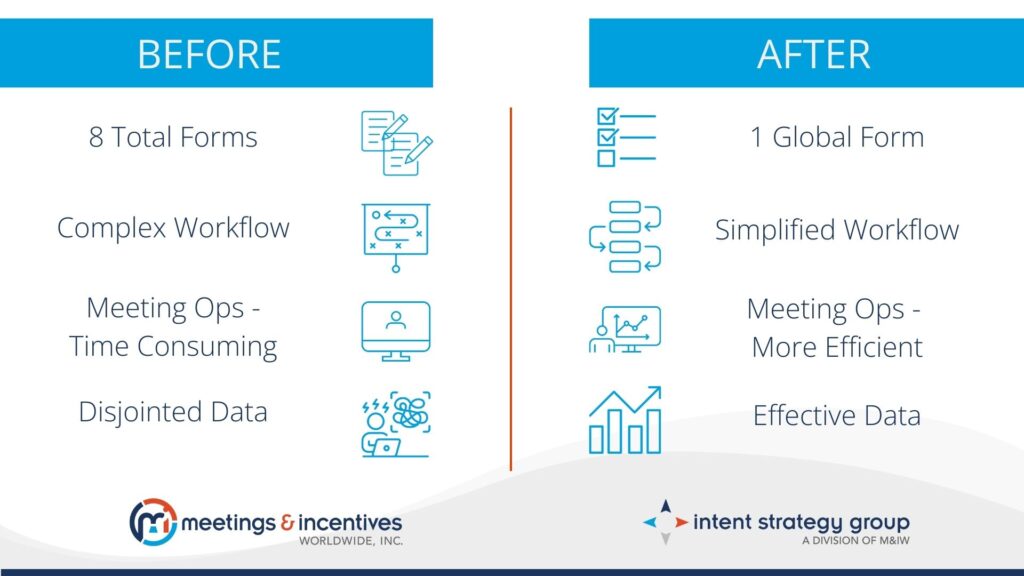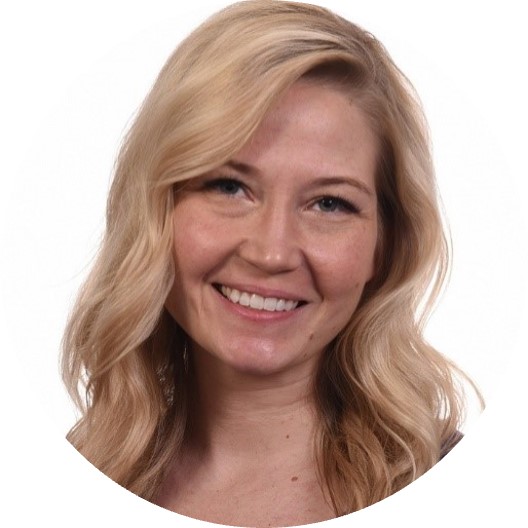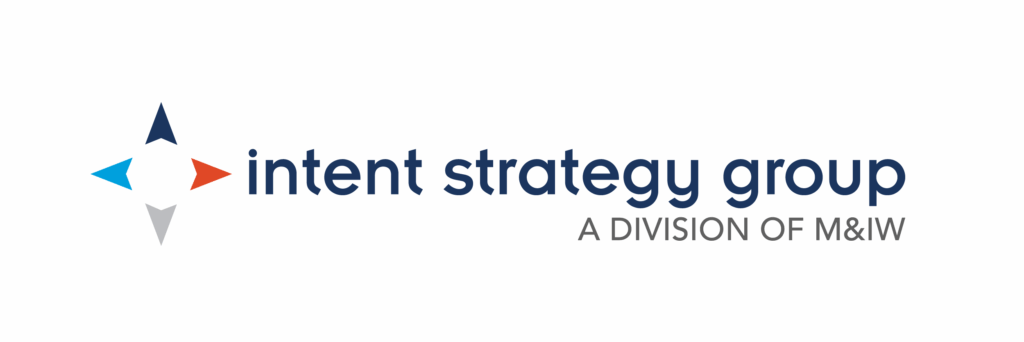Efficiency Unleashed: Transforming Global Meeting Requests
Intent Strategy Group (ISG) is a division of M&IW dedicated to holistic solutions for SMM, meeting request forms, and other technology initiatives. We love to share their success stories, and Linsey Giant, Principal Consultant, ISG, did just that at Cvent CONNECT 2024. She presented the session Efficiency Unleashed: Aon’s Streamlined Approach to Global Meeting Requests that Save Time with her co-presenter, Chelsea Kucera, Sr. Manager, Global Meeting Operations, Aon.

Aon and ISG’s relationship began three years ago, growing from simple Cvent management to the strategic partnership we have today. As their session title suggests, this success story centers around a recent SMMP transformation project that saw multiple meeting request forms (MRFs) consolidated into one global form. Let’s dive in!
Aon’s MRFs Before and After
Before embarking on this project, Aon had eight total forms, including multiple region-based and virtual MRFs as well as processes outside of Cvent. The overall workflow was highly complex, with four approval processes, 195 triggers, 45 MRF statuses, and 388 email notifications. Naturally, this led to time-consuming meeting operations requiring a lot of manual intervention, including fixing errors and adding approvers. Because fields were not shared between forms and workflows, this resulted in disjointed data, so Aon didn’t have a full picture of their M&E program.
With ISG’s help, everything was consolidated into one global form that saw a 30% reduction in questions and an improved user experience. There was a 60% overall reduction in workflow with one integrated approval process for all regions, and meeting operations are now much more efficient with request processing reduced by 80%. Because there is less manual work, there is more time to focus on strategy and growth, especially since the new process led to more consistent and accurate data across all regions.

Three Keys to Success
Although this project was a huge undertaking, ISG’s expert guidance led to all three goals being achieved: enhancing the requester experience, reducing the time required for various resources, and allowing for scalability to expand globally. Such a resounding success wouldn’t have been possible without a commitment to three key components: deep analysis, simplicity, and automation.
Deep Analysis
The first step of the project was a deep analysis of the then-current processes and feature usage. As Linsey noted in the Cvent CONNECT presentation, it was critically important to go both broad and deep when conducting their analysis and to include an outside view to help identify areas of improvement that might otherwise be missed.
Other key tasks during the analysis period included:
- Reviewing the full system usage and processes, including underutilized, unused, and unknown features as well as the current MRF and workflow. Workflows should evolve as an organization evolves, so Aon had to consider if their current needs were met.
- Documenting findings along the way. This made it easier to review the analysis internally and create a plan to move forward. Plus, when the analysis inevitably got sidetracked by other more time-sensitive projects, it was easier to pick up where they left off.
- Considering all groups that may be impacted by the findings, including internal clients, meeting planners, third-party suppliers, and meeting operations team. The goal was a streamlined process for all parties, not just one group.
- Prioritizing goals. Remember, if you try to do everything, you’ll accomplish nothing. Factors considered when prioritizing include cost, time, and overall impact.
Simplicity
Simplicity increased scalability, time savings, and the rate of adoption. ISG and Aon prioritized simplicity by:
- Eliminating redundancy and consolidating features and processes as much as possible. Aon achieved this by moving all processes into Cvent and turning eight forms into one global form.
- Removing unnecessary processes. This may seem obvious, but many times, something is kept because that’s how it’s always been done. For example, Aon’s previous form required both regional leaders and the finance department to approve every request; after review, it was decided that regional leaders’ approval was no longer needed.
- Limiting customization without sacrificing service. This was especially applicable to Aon’s global form as too much customization is not scalable. Evaluate the risks and rewards of a customized experience with the added complexity and maintenance requirements.
- Minimizing system admin maintenance. Time is money! By reducing maintenance requirements, Aon freed up time to devote to strategy, growth, and other high-level focuses.
Automation
Another way to simplify processes and save time is with automation. Cvent allows automation in various ways. Aon used automation in data tags, advanced logic, email notifications, and approvals in addition to these specific examples.
Sub-questions and Advanced Logic
Sub-questions and advanced logic helped customize the requestor experience and made the MRF as complete and accurate as possible. One example Aon used that is applicable to many organizations is meeting type, which can be in-person, hybrid, or virtual. Once the requestor selects the appropriate type, this automatically influences the rest of the questions in the form. A virtual event, for example, doesn’t need to ask questions about hotel needs.
Role Triggers
Aon used role triggers to save manual resources by automating the assignment of sourcing agents, web builders, marketers, planners, and virtual producers based on various MRF responses. There was more upfront work setting up these automated triggers, but once it was in place, it was quicker and easier than manually making assignments.
Integrations
Integrations are helpful for parts of the process that can’t be consolidated into Cvent. For example, Aon initially had a manual process of looking up, copying, and pasting approvers. By implementing a custom integration with their finance system, this process is now automatic and globally consistent.
Benefits of More Efficient Global Meeting Request Forms
The end result of this project isn’t just a faster, simpler request form but also an improved ability to make decisions based on data. This was achieved through:
- Improved visibility. Having just one global form led to greater transparency, including increased visibility on spend and the creation of a global calendar of events.
- Risk mitigation. With compliance requirements moved into Cvent, automations are now triggered when certain requirements are met so nothing is missed.
- Spend governance and insights. The improved spend visibility drives savings and eliminated redundancies, giving more financial control to leadership.
- Metrics and reporting. With both high-level and detailed reporting available, it is now easier to determine the value of meetings and events as well as the potential ROI across all events.
In Chelsea’s own words, “The efficiencies [Aon] gained through this transformation project resulted in more adoption of our M&E program, policies, and technologies… Overall, this project was extremely impactful to our leadership and our firm as we move forward.”
Future Success
ISG’s next success story could be with your organization! Whatever your SMM needs, from global meeting request forms to small meetings management and more, contact us for a consultation or to learn more. Already an M&IW customer? Contact your Customer Success Manager.
Contributors

Linsey Giant
Principal Consultant
Intent Strategy Group

Chelsea Kucera
Sr. Manager, Global Meeting Operations
Aon


